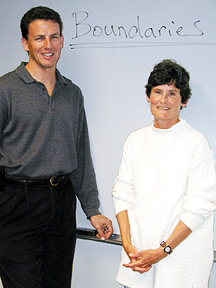'Tis the Season for Good Boundaries
By Mika Ono
Why set limits? And how do you set them? These were questions
addressed in a recent standing-room-only seminar "Boundaries:
the Importance of Limit Setting" for employees of The Scripps
Research Institute (TSRI).
"It is no accident that we're doing the seminar on boundaries
at this time of year," said Jan Hill, director of the Employee
and Graduate Student Counseling Department, who presented
the event with her TSRI colleague, Counselor Jeff Jones on
December 6. "The holidays can present challenges at both work
and home."
Hill and Jones kicked off the workshop by challenging participants
to define what "boundaries" meant to them, noting that it
was a word often used in psychology derived from usage in
a geographical sense. Answers from the audience included "acceptable
behavior," "rules of conduct," "limits," and "expectations."
"Limit setting is important because it goes hand-in-hand
with issues of safety and respect," noted Hill. "If boundaries
are crossed, people don't feel respected or safe; instead
they feel anxiety, discomfort, or low self-esteem. Good boundaries
create a sense of emotional safety."
Jones related the concept of boundaries to ideas from the
assertiveness movement, begun some 30 years ago, that described
personalities on a continuum from passive to aggressive. According
to this model, passive personalities put the needs of others
before themselves, permit others to infringe upon their rights,
and are indirect and self-denying. These behaviors lead to
accumulated anger and low self-respect.
On the other end of the spectrum, aggressive personalities
focus on their own needs above others, express their rights
at others' expense, and are goal-driven and brutally honest.
This goes hand-in-hand with a sense of righteousness. Aggressive
types also tend to suffer low self-esteem.
The goal is to be in the middle of the continuum—with
behavior, Jones states that can be learned with practice.
Assertive personalities are able to express their own needs
with an awareness of others, are honest and direct while considering
others' needs and feelings. This behavior leads to a sense
of confidence and self-respect and a feeling of being valued
by both self and others.
More specifically, steps to assertive behavior can include:
- Describing a behavior that is bothering you in a non-threatening
way; for example, "When you stand so close to me..."
- Expressing the feeling that this engenders, for example,
"... I feel uncomfortable..."
- Specifying the change in behavior that you would like,
"...so I would like to be given more personal space..."
- Outlining possible consequences, "...or I will have to
leave the room."
Members of the audience engaged in a thoughtful discussion
of these ideas. Points that were raised included:
- The context of culture, situation, and gender is important;
behavior considered aggressive in one arena is interpreted
as assertive in another.
- Confrontation should ideally take place in private.
- This technique works best when both people are calm.
- Anger can cover anxiety; and anxiety can mask anger.
"Unfortunately, there is no guarantee," said Jones. "People
you talk to won't necessarily follow your script. However,
practice, practice, practice, and I believe assertive behavior
will get reinforced..."
This event was part of the quarterly "Personal Skills for
Life and Work" seminar series presented by the Employee and
Graduate Student Counseling Department that has been focusing
on issues related to stress management. Jones and Hill also
offer TSRI employees, graduate students, and family members
free, confidential one-on-one counseling sessions. For more
information, contact Hill, x4-2950 or e-mail janhill@scripps.edu,
or Jones, x4-2063 or e-mail jjones@scripps.edu.

|

Jeff Jones and Jan Hill of TSRI's Employee
and Graduate Student Counseling Department give quarterly
workshops as part of the "Personal Skills for Life and Work"
seminar series. Photo by Jason S. Bardi.
|

